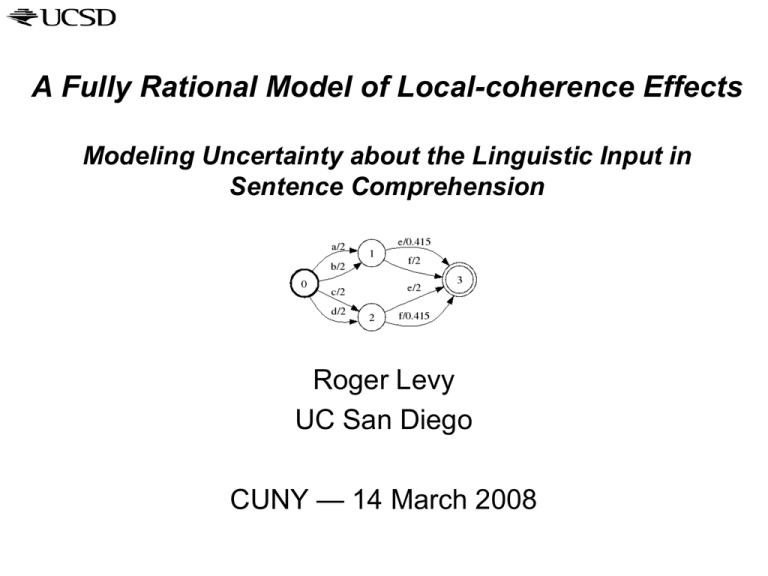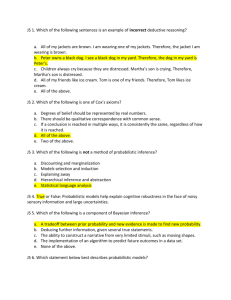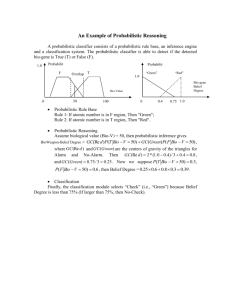PPT
advertisement

A Fully Rational Model of Local-coherence Effects
Modeling Uncertainty about the Linguistic Input in
Sentence Comprehension
Roger Levy
UC San Diego
CUNY — 14 March 2008
Incrementality and Rationality
• Online sentence comprehension is hard
• But lots of information sources can be usefully brought
to bear to help with the task
• Therefore, it would be rational for people to use all the
information available, whenever possible
• This is what incrementality is
• We have lots of evidence that people do this often
“Put the apple on the towel in the box.”
(Tanenhaus et al., 1995)
But…what do you think of this sentence?
The coach smiled at the player tossed the frisbee.
…and contrast this with:
The coach smiled at the player thrown the frisbee.
The coach smiled at the player who was thrown the frisbee.
(Tabor et al., 2004)
Why is this sentence so interesting?
• As with classic garden-path sentences, a part-of-speech
ambiguity leads to misinterpretation
• The horse raced past the barn…
verb?
participle?
• But here, context “should” be enough to avoid garden-pathing
• The coach smiled at the player tossed…
verb?
participle?
• Yet the main-verb POS “interferes” with processing
Behavioral correlates (Tabor et al., 2004)
tossed
harder than
thrown
• Also, Konieczny (2006, 2007) found compatible results in stopsmaking-sense and visual-world paradigms
• These results are problematic for theories requiring global
contextual consistency (Frazier, 1987; Gibson, 1991, 1998; Jurafsky,
1996; Hale, 2001, 2006)
Contextual constraint & rationality
• Let’s recast the problem in even more general terms
• Rational models of comprehension: the comprehender
uses all the information currently available
• In local-coherence sentences, the comprehender
seems to be systematically ignoring available
information
• Local-coherence effects’ challenge: to what extent is
human sentence comprehension rational?
Existing proposed theories
• Proposed models posit a context-ignoring, bottom-up
component of comprehension:
• Gibson, 2006
• Tabor & Hutchins, 2004; Tabor, 2006
• Hale, 2007
• To the extent that these models are rational, it can
only be in terms of “bounded rationality” (Simon 1957)
• To what extent do we want to bound the rationality
of human sentence comprehension?
Today’s proposal
• I simply want to argue that it is premature to conclude
from local-coherence effects that the parser’s
rationality must be bounded in this respect
• There is another possibility that has been overlooked
thus far
• Instead of relaxing the assumption about rational use
of context, we may instead have misspecified the input
representation
Relaxing assumptions about input
• Traditionally, the input to a sentence-processing model
has been a sequence of words
• But really, input to sentence processor should be more
S
like the output of a word-recognition system
NP
Det (couch?)
N
VP
V
(and?)
…
(as?)
(that?)
(who?)
these changes would
make main-verb tossed
globally coherent!!!
The coach smiled at the player tossed the frisbee
• That means that the possibility of
misreading/mishearing words must be accounted for
• On this hypothesis, local-coherence effects are about
what the comprehender wonders whether she might
have seen
Inference through a noisy channel
• So how can we model sentence comprehension when
the input is still noisy?
• A generative probabilistic grammatical model makes
inference over uncertain input possible
• This is the noisy channel from NLP/speech recognition
• Inference involves Bayes’ Rule
Prior: Comprehender’s
knowledge of language
Evidence: Noisy input probability, dependent
only on the “words” generating the input
Representing noisy input
• How can we represent the type of noisy input
generated by a word sequence?
• Probabilistic finite-state automata (pFSAs; Mohri, 1997) are
a good model
vocab = a,b,c,d,e,f
Input symbol
Log-probability
(surprisal)
• “Word 1 is a or b, and I have no info about Word 2”
Probabilistic Linguistic Knowledge
• A generative probabilistic grammar determines beliefs
about which strings are likely to be seen
• Probabilistic Context-Free Grammars (PCFGs; Booth, 1969)
• Probabilistic Minimalist Grammars (Hale, 2006)
• Probabilistic Finite-State Grammars (Mohri, 1997; Crocker & Brants 2000)
Input symbol
Log-probability
(surprisal)
• In position 1, {a,b,c,d} equally likely; but in position 2:
• {a,b} are usually followed by e, occasionally by f
• {c,d} are usually followed by f, occasionally by e
Combining grammar & uncertain input
• Bayes’ Rule says that the evidence and the prior
should be combined (multiplied)
• For probabilistic grammars, this combination is the
formal operation of intersection (see also Hale, 2006)
input
grammar
+
=
BELIEF
Grammar
affects
beliefs
about the
future
Revising beliefs about the past
• When we’re uncertain about the future, grammar +
partial input can affect beliefs about what will happen
• With uncertainty of the past, grammar + future input
can affect beliefs about what has already happened
word 1
{b,c} {?}
grammar
words 1 + 2
{b,c} {f,e}
Ingredients for the model
• To complete our rational model of local coherence
effects, we need the following components:
• A probabilistic grammar
• A systematic mapping from sentences to noisy (pFSA)
inputs
• A quantified signal of the alarm about representations
of the past that is induced by the current word
• I’ll present these ingredients in the form of an
experiment on the “classic” local-coherence sentence
1. Probabilistic Grammatical Knowledge
• We can transform a (strongly regular) PCFG into a
weighted FSA
• We use the following grammar with surprisal values
estimated from the parsed Brown corpus
7.30
0.01
0.00
3.71
0.11
0.00
2.02
0.69
2.90
0.00
S -> S-base Conj S-base
S -> S-base
S-base -> NP-base VP
NP -> NP-base RC
NP -> NP-base
NP-base -> Det N
VP -> V PP
VP -> V NP
VP -> V
PP -> P NP
0.47 RC -> WP S/NP
2.04 RC -> VP-pass/NP
4.90 RC ->
WP FinCop VP-pass/NP
0.74 S/NP -> VP
1.32 S/NP -> NP-base VP/NP
3.95 VP/NP -> V NP
0.10 VP/NP -> V
2.18 VP-pass/NP -> VBN NP
0.36 VP-pass/NP -> VBN
2. Sentence noisy input mapping
• There are lots of possibilities here
• Our implementation: start with the sequence of
actually observed words
• Make every lexical item (including <eps>) probable in
proportion to Levenshtein (string-edit) distance
Dist(dog, cat)
= 3
Dist(<eps>, toes) = 4
Dist(the, toe)
Dist(goth, hot)
= 1
= 2
3. Error identification signal (EIS)
• Relative Entropy (KL-divergence) is a natural metric of
change in a probability distrib. (Levy, 2008; Itti & Baldi, 2005)
• In our case, the distributions in question are
probabilities over the previous words in the sentence
• Call this distribution Pi(w[0,j))
• The size of the change in this distribution induced by
the i-th word is EISi, defined as
new distribution
old distribution
Error identification signal: local coherences
• Full experiment:
• Probabilistic grammar with rule probabilities estimated
from parsed Brown corpus
• Lexicon with all <tag,word> combinations of frequency
>500 in parsed Brown corpus (plus sentence wds)
• Error identification signal as defined above
EIS = 0.07
The coach smiled at the player tossed
The coach smiled at the player thrown
EIS = 0.0001
• The important part of the change is that at can be reinterpreted as and or other near-neighbors
But, you may protest…
• Most items in Tabor et al., 2004 did not involve the
preposition at before the modified noun
• For example:
who/that/and
The manager watched a waiter served/given pea soup by a
trainee.
• But these sentences can also involve revisions of past
beliefs—specifically, that a word has been missed
Missed words
• Modeling beliefs about missed words requires only a
minor modification to the noisy-input representation
hallucinated word insertions
Missed words (II)
• Experiment 2: stimulus without the preposition at
EIS = 0.0168
The manager watched a waiter served…
The manager watched a waiter given…
EIS = 0.0117
• The difference in error-identification signal is much
smaller, but we still get it
Other potential applications of theory
• “Good-enough” processing representations (Ferreira et
al., 2002)
While Anna dressed the baby played in the crib.
• “Morphological mismatch” processing effects in cases
of superficial semantic mismatch (Kim & Osterhout, 2005)
The meal devoured…
• Modeling longer-distance regressions in reading of
naturalistic text
What the model is still missing
• Lots of things! But a couple of things most sorely
missed:
• Trans-finite-state probabilistic rules (technical, not theoretical
shortcoming)
• Richer probabilistic information sources, such as
plausibility of noun-verb match (statistical, not theoretical
shortcoming)
more difficult
(Tabor et al., 2004)
The bandits worried about the prisoner transported…
The bandits worried about the gold
transported…
less difficult
Acknowledgements
the people that
• Thank you for all yourhelp!
• UCSD Computational Psycholinguistics Lab:
•
•
•
•
•
Adam Bickett
Klinton Bicknell
Gabriel Doyle
Albert Park
Nathaniel Smith
• Cyril Allauzen and the rest of the developers of the
OpenFst (http://openfst.org) and GRM libraries
(http://www.research.att.com/~fsmtools/grm/)
Thank you for listening!
http://idiom.ucsd.edu/~rlevy








